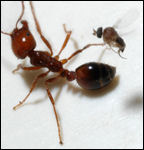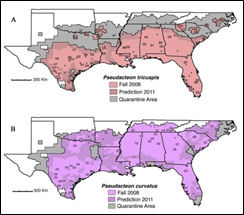ARS Home
» Southeast Area
» Gainesville, Florida
» Center for Medical, Agricultural and Veterinary Entomology
» Imported Fire Ant and Household Insects Research
» Docs
» Phorid Flies as Biocontrol Agents
| Phorid Flies as Biocontrol Agents |

|
 Phorid flies in the genus Pseudacteon are 1) highly specific parasitoids, 2) broadly distributed across geography and climate, and 3) strongly affect fire ant foraging behavior. Maggots of these miniature flies develop in the heads of fire ant workers, decapitating their host upon pupation.
Phorid flies in the genus Pseudacteon are 1) highly specific parasitoids, 2) broadly distributed across geography and climate, and 3) strongly affect fire ant foraging behavior. Maggots of these miniature flies develop in the heads of fire ant workers, decapitating their host upon pupation. At least 24 species of Pseudacteon flies have been found attacking fire ants in South America. Different species partition niche space by host size, season, time of day, and mode of attack. Certain fly species or biotypes prefer different fire ant hosts.
Fire ant workers are keenly aware of the presence of phorid flies. A single fly usually stops or greatly inhibits the foraging efforts of hundreds of workers. Reduced foraging facilitates competition from ants that might otherwise be excluded from food sources in fire ant territories. Morrison and Porter reported that the impacts of a single species of fly (P. tricuspis) did not rise above background variability (10-30%). However, the impact of all phorid species in South America is clearly sufficient to have caused the evolution of a number of phorid-specific defense behaviors and these behaviors could only have evolved if Pseudacteon flies impact the production of sexuals. Roadside surveys indicate that fire ant populations are lower in the last several years (2011-2013) than they were in the 1990s before phorid fly releases. Other studies have shown that decapitating flies disrupt foraging, potentially vector pathogens, and parasitize up to 5% of colony workers.
 Six species of decapitating flies have been established in the USA on red imported fire ants. Two species (P. tricuspis and P. curvatus) are now widely distributed across the southeastern USA. Densities of P. curvatus are about 10-fold those of P. tricuspis, probably because of the greater abundance of small workers in fire ant colonies. A third species (P. litoralis), which attacks large fire ants is established and expanding in Alabama while a fourth species (P. obtusus) has been established at multiple sites in Texas and Florida. A fifth species (P. nocens) has recently been established by another research group in Texas and a sixth species (P. cultellatus) is established at two sites in Florida.
Six species of decapitating flies have been established in the USA on red imported fire ants. Two species (P. tricuspis and P. curvatus) are now widely distributed across the southeastern USA. Densities of P. curvatus are about 10-fold those of P. tricuspis, probably because of the greater abundance of small workers in fire ant colonies. A third species (P. litoralis), which attacks large fire ants is established and expanding in Alabama while a fourth species (P. obtusus) has been established at multiple sites in Texas and Florida. A fifth species (P. nocens) has recently been established by another research group in Texas and a sixth species (P. cultellatus) is established at two sites in Florida.
For information about phorid fly rearing see: Rearing Pseudacteon cultellatus and Rearing Pseudacteon bifidus.
